The Magic of Ice Wine: A Frozen Delight
Imagine the first cold snap of the winter. The leaves have fallen, and the world is still and quiet. The grapes are left to hang on the vine long past the hustling, bustling harvest. Then, picked at the precise moment, nature freezes and transforms them into a sweet, concentrated nectar. This is ice wine. It is a rare, unique wine born of patience, precision, and artistry. A few adventurous winemakers embrace the cold to create something truly extraordinary.
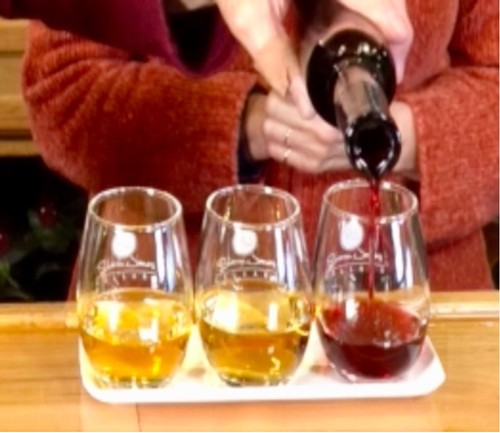
Flight of Ice Wine at Cold Country Wines
Ice wine is a sweet, intense, and utterly enchanting wine only made in the colder grape-growing regions. True wine connoisseurs are drawn to it because of its exaggerated display of the varietal nature of every grape used to make it.
Ice wine is produced by picking frozen grapes and pressing them immediately so that the frozen ice inside the grape will remain with the skins while the thick, syrupy juice is squeezed out. The best part is that it is all-natural. No chemicals, no sugar of any kind except what it already has, and no artificial production methods.
The Origins of Ice Wine
The question of who invented ice wine comes up often. The majority of stories revolve around the Germans inventing it by accident in a sub-par growing year. The dates I’ve read range from the mid-18th century to the early 20th century. I’m absolutely sure that the stories will keep changing because very little of this was ever written down. Many times the grapes must be picked at night but sometimes you get lucky.
The legend talks about the German grape grower who lost his crop to an early frost. When he tasted the grapes to find out if he could salvage the juice, he was surprised by the flavors the grapes portrayed.
The important part of the origins of ice wine is that it started becoming popular in the mid-20th century. It started gaining popularity in the US in the seventies after Canada started producing exceptionally high-quality offerings.
Now, ice wine is grown in a number of countries, with the biggest producer being Canada. After that comes China, Germany, and the US.
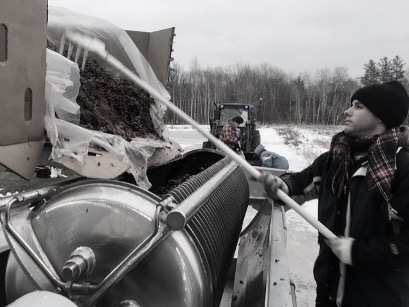
Pressing ice wine grapes with a vintage press
The Science Behind Ice Wine
The concept of making ice wine is not hard to understand. You leave the grapes on the vine until they are frozen. You then press the grapes while frozen so that the frozen ice inside the grape will stay with the skins. This results in the extracted juice being more concentrated than it would otherwise have been. Wine is then made from this syrupy liquid.
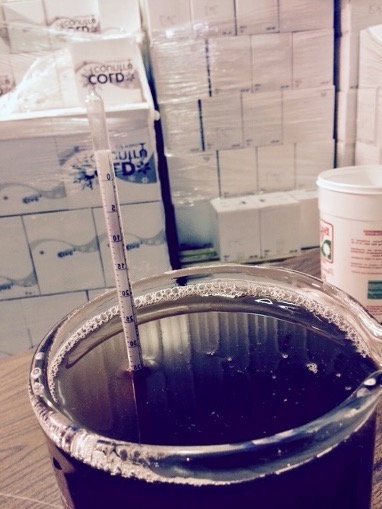
Checking sugar content with a hydrometer
The process is a very simple concept but very difficult to execute. Just some of the hurdles to jump are:
- All kinds of animals are attracted to the grapes as they get sweeter on the vine
- International Trade Regulations are very strict about exactly how Ice Wine can be harvested and processed.
- The weather is never a friend. Even if you get the right temperature, will you actually be able to pick? Sometimes, the snow gets too deep, and other times, the temperature will drop well below what is required to press the grapes. As the temperature drops below 10 degrees, the grapes get harder and harder to press any juice out of.
- Can you find enough help to pick in those cold temperatures? Can you get people to pick in the middle of the night?
- An equipment failure that cannot be repaired immediately could result in disqualification of the wine. If the weather warms up either that same day or overnight, the International Trade Laws will no longer let you label it as Ice Wine.
Ideally, you would have a day starting at about 12 degrees and never getting above 17. No wind or snow, but also not too much sunlight. Sunlight can melt the grapes even if the temperature remains low.
You should probably have about twice the number of pickers you would normally have for picking Fall grapes. If you can get the grapes picked in 4 or 5 hours and get them pressed in 2 or 3 hours, you will be in great shape.
Now, this might sound discouraging, but the final result is the most exquisite wine made in North America.
The Taste Profile of Ice Wine
WOW! Is what you hear most often. People who’ve never tasted Ice Wine are usually amazed at the vast complexity in just a tiny sip.
- Ice Wines range from slightly sweet to enormously sweet. This is directly related to several factors.
- The sweetness of the grape at picking
- Stopping fermentation too early or too late
- Total acidity of the grape juice
- How hard the grapes are pressed
The only one of these factors that can be controlled after picking is the length of time it is allowed to ferment. Fermentation reduces sugars at the same time; it produces alcohol and a number of compounds that give the wine its unique flavors.
Any grape can be used to make Ice Wine, but the two most popular are Riesling and Vidal Blanc. Since the development of cold-climate hybrids, this book has gained a whole new chapter. These grapes are usually grown in the North, where higher acid levels can be achieved. In Ice Wine, that is a good thing. The acid balances out the sugar to make a flavorful journey across the palate.
What flavors can you expect? Honey, melon, apricot, cherry, among hundreds of others. Some of the Ice Wines I’ve tasted are almost sensory overload. You have to limit your sips to a very tiny amount to really appreciate the wide range of flavors in any particular wine.
I often get asked what I would pair Ice Wine with. I might be a little old-fashioned here, but I like just sipping on one or two ounces after dinner, paired with nothing. Others tell me that Ice Wine pairs well with fruit-based desserts, blue cheese, and chocolate. Of course, everything pairs well with chocolate.
Ice Wine Production: A Labor of Love
The vines that are set aside must have special care. First, there is the crop load. If you overcrop, the grapes will take too much out of the vine, and the next spring will produce a weak amount of growth. Special care with crop load and fertilization is required.
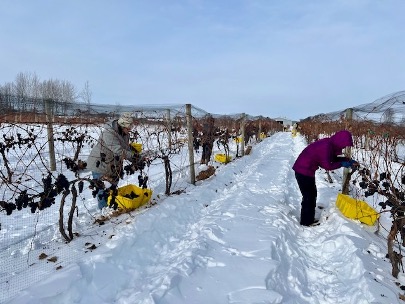
Pickers are dressed warm for this frigid event
Creating Ice Wine is not all that easy. As the grapes hang on the vine through late Fall, the grapes naturally dehydrate. This makes the juice get much sweeter even before the freezing process starts. Herein lies the problem: the wild animals love the sweet juice as much as the humans love the wine. Deer, birds, and raccoons, among others, will completely rob the entire crop if the vineyard caretaker is not on his or her toes. Netting, electric fences, and noisemakers are some of the methods used to deter pesky rodents. Even with constant surveillance and maximum deterrence, some years will be a complete loss. That’s why you’ll hear some vineyard managers say that planning an Ice Wine crop is like spinning the roulette wheel.
Once the Ice Wine is picked, the problems are not over. Ice Wine grapes are also very hard on the equipment. Presses have all kinds of problems when working in sub-freezing weather. Then comes filtering. My own experience leads me to the conclusion that filtering Ice Wine is like filtering mud. It can be done, but things plug up fast, so you have to have a lot of filters and a lot of time.
Ice wine is usually bottled in 375ml bottles or smaller. This is again somewhat more difficult than a normal 750ml bottle. At this point you are happy to be finished.
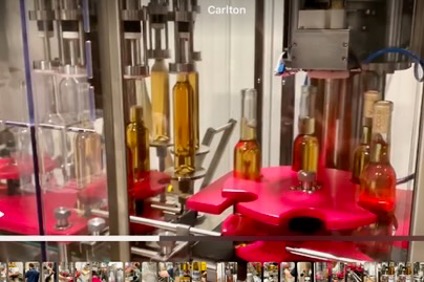
Bottling ice wine in 375ml flint bottles
The Role of Ice Wine in the Wine Market
Once you are done with the protection, the picking, and then the grueling process of filtering, and finally bottling, it’s time to bring your wine to market. The demand for Ice Wine is pretty middle-class wine drinker often purchases a few bottles a year for those special occasions that come up during the year.
The biggest problem with the market is that the majority of areas where grapes are grown do not have the weather to produce ice wine. This is a problem for them but a huge advantage for us Northern Folk. 40% of the world’s Ice Wine comes from North America. Most of this comes from Canada. However, Wisconsin, Michigan, and New York are catching up quickly.
The demand for Ice Wine is moderately high. Affluent beginner wine drinkers, along with dessert wine lovers, look at ice wine as one of the top offerings in the North. The real increase in demand didn’t start until the 1980s when some of the wineries in Ontario started producing it commercially. At one point, ice wine was nearly 50% of Canada’s exports.

Group of people celebrating with an ice wine toast
The Future of Ice Wine
What’s in our future for ice wine? I personally think it will remain very popular for some time to come. Much of the picture will depend on the trade regulations that now control the process of production. Some of the countries outside of North America are allowed to use a cryo process. This doesn’t really accomplish the task completely. First, the grapes must stay on the vine for some time before being harvested, even if you get cold temperatures. This allows the grapes to dehydrate somewhat beforehand, increasing the sugars into the sweet spot. Somewhere around 36% to 46% sugar content. Second, the biological breakdown of the grape pulp adds the most interesting flavors.
So, why don’t they just leave the grapes on the vine? Mostly because many of the places that used to produce consistent ice wine crops no longer get cold enough temperatures. This is a problem for many of the borderline areas. And most of the early producers were borderline. The good news is that the North country still gets plenty cold to produce ice wine and will for the foreseeable future.
The Enduring Charm of Ice Wine
The art of winemaking has been evolving for nearly 10,000 years. Although ice wine is a relative newcomer to the current family of wines, most wine lovers believe it is here to stay. The ice wine aficionados will keep this sacred brew popular for centuries to come.
A glass of ice wine is like sipping of frozen sunshine, is how the romanticists describe it, and if you live in the North as I do, it kind of validates the reason to grow grapes in a cold climate like this.
Is there anything better? If you like intensely flavored and sweet wine, there is one possibility. Hungary makes some wines that are even sweeter than the sweetest ice wine. The one wine I’ve had the privilege of trying was Royal Tokaji, Essencia. It was an amazingly sweet and complex wine that sells for upwards of $1000 per bottle. As good as this wine tasted, ice wine is something you can travel the world to sample hundreds of wonderful wines at prices the average wine lover can afford.
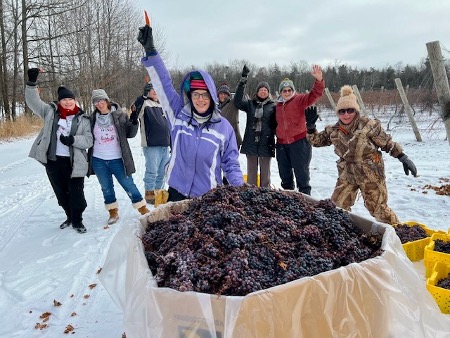
Despite all the struggles, everyone enjoys Ice Wine Harvest
